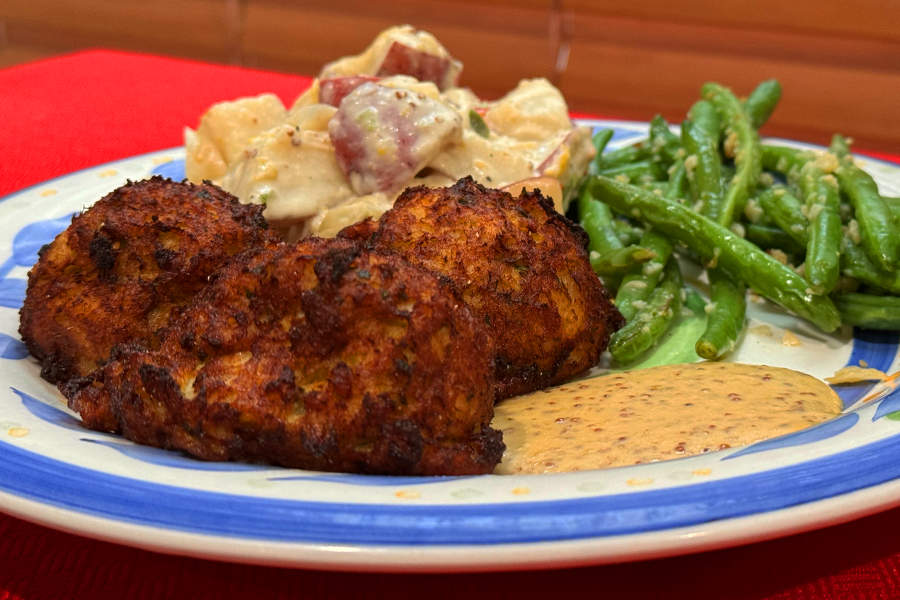Could the blue catfish “cattie” be the Bay’s next best recipe?
Blue catfish are the star of a new sustainable dish

As the saying goes, when life gives you lemons, make lemonade.
Well here in the Chesapeake Bay, we’re taking the blue catfish—a predator species that’s causing mayhem within the ecosystem—and making catties.
What, you might ask, is a cattie?
To answer this question, we first need to define its predecessor, the coddie.
Often referred to as “the poor man’s crab cake,” the coddie is a dish that was once a common staple across dinner tables and restaurant menus in Baltimore and Maryland’s Eastern Shore. The recipe calls for a mix of mashed potato and salted cod, often served between two Saltines with a side of mustard. While the origin of the coddie is unknown, a prevailing theory is that it was invented by Fannie Jacobson Cohen as a non-kosher crabcake to sell at her family’s market in Bel Air, Maryland.
To put a modern twist on the old-timey bite, we recommend substituting blue catfish for cod in order to create a “cattie”, a dish that is as good for the Bay as it is for your belly.
Blue catfish is a non-native species that was brought over and dumped into the James River in the 1970’s for recreational fishing. Over time, the species has moved into the Chesapeake Bay where it is now notorious for eating blue crabs, striped bass and other smaller fish while procreating at high rates. The fewer blue catfish we have in the Bay the better, which means that eating the surprisingly tasty and nutritious fish is beneficial to the ecosystem.
It is this reason that inspired Chef John Shields to put the cattie on his menu at Gertrude’s Chesapeake Kitchen. The chef does not claim to be the inventor of the cattie, though he does provide a wonderful tutorial for making the dish on his YouTube channel, Our Common Table. In the name of journalistic integrity, we tried the restaurant’s cattie and can confirm it is truly delicious.
But catties aren’t the only way to serve up blue catfish. Restaurants across Maryland and Virginia are starting to offer blue catfish sandwiches and blue catfish cakes on their menus. In fact, one recipe for a blue catfish cake may make it into public school lunches, not just in Maryland, but across the country.
According to Beth Brewster, the supervisor of food services for Caroline County Schools, the Maryland Department of the Agriculture came to her with the idea of putting blue catfish in school lunches. Brewster, who is as passionate about the Bay as she is about food sustainability, loved the idea and had her chefs put together a recipe.
“We served it to the kids and they loved it,” Brewster said.
Brewster is a member of the Chesapeake Bay Program’s Invasive Catfish Workgroup. Through her connections with the workgroup and other like minded seafood distributors, she is working to get the blue catfish cake into school lunches across the United States. Once finalized, the dish will have a Child Nutrition Label that means it is recognized by the U.S. Department of Agriculture (USDA).
Getting blue catfish out of the water and onto plates, whether that’s at schools, restaurants or homes, can be a bit of a challenge. The fish has a special regulation in place that requires facilities to be approved by the USDA before they can process the fish. To get approval, facilities often have to purchase expensive new equipment. An inspector from the USA also has to be present at facilities when blue catfish are being processed. This can lead to a lack of processors which makes it harder for markets and restaurants to get the fish and introduce it to customers.
The other issue is safety. Like most species in the Bay, blue catfish consume and accumulate chemical contaminants through their diet, which can pose health risks for people who eat the fish. Health risks can be reduced by following consumption advisories. Taking into account where the fish was caught, what size it was and whether the fish is being eaten by the general population, a woman of child bearing age, or a child, the advisories recommend a wide range of consumption advice. Advice ranged from avoiding any consumption, to a certain number of meals a month, to no limit of meals per month.
When it comes to the blue catfish cake, Brewster worked with the Maryland Department of the Environment on establishing the appropriate amount of blue catfish to serve in schools.
Despite these challenges, progress is being made. In Virginia, Governor Younkin introduced a grant program that provides grants of up to $250,000 to help processors purchase the necessary equipment for handling blue catfish. More and more restaurants in Maryland are starting to serve the fish in creative ways. And getting blue catfish into schools could help a whole new generation of people get a taste for the abundant seafood.
We are hopeful of a day when the cattie or blue catfish cake is a staple of the Chesapeake (that is, until there are no more blue cats in the water to eat). In the meantime, we encourage you to purchase some blue catfish from a market or grocery store and give either the cattie or blue catfish cake recipe a try. Let us know how it goes in the comments below!

Comments
Here is a direct link to the Catties recipe on Chesapeake Bites - our online cooking show showcasing 3-12 minute recipes from Gertrude's owner and founder of our non-profit Our Common Table:
https://www.youtube.com/watch?v=wnYZavo7dIM
Thank you!
Your comment has been received. Before it can be published, the comment will be reviewed by our team to ensure it adheres with our rules of engagement.
Back to recent stories